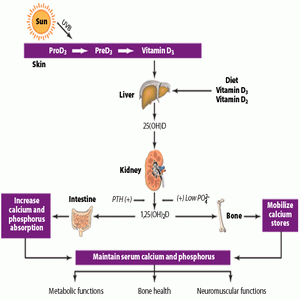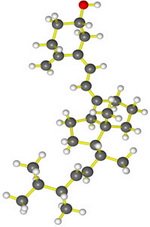|
Vitamin D – Its Dual Role As Both Vitamin And HormoneVitamin D is unique among vitamins, because the human body can actually synthesize this vitamin by taking in enough sunlight. In fact when the skin is exposed to the ultraviolet rays of the sun, there is a cholesterol precursor 7-dehydrocholesterol that is converted into cholecalciferol or vitamin D3; therefore, the vitamin is not really necessary in the diet, since if we get enough sunlight we can make all we need.
The vitamin is not a true nutrient because it functions more like a hormone, and is viewed as both a vitamin and a hormone. The active form of the vitamin is like a hormone because it is made in one part of the body and has actions as a regulator of functions in other parts of the body. The vitamin is essential for bone health, in children it promotes bone development and growth, in adults it is essential for bone maintenance, and in the elderly it helps to prevent osteoporosis and fractures, and as a supplemental vitamin can help to reduce falls risk in the elderly.
The vitamin in the forms D1 through D10 act to prevent a childhood bone disease called rickets. The two most important compounds of the vitamin are Vitamin D2 also called ergocalciferol, found exclusively in plant foods and Vitamin D3 cholecalciferol found exclusively in animal foods such as eggs and fish oils. The primary source of the vitamin however is that which is synthesized in the skin cells, which once it is converted by ultraviolet (UV) radiation from the sun from 7-dehydrocholesterol to Vitamin D3, enters the blood stream and travels to the liver, which converts Vitamin D2 and Vitamin D3 to calcidiol and sends it to the kidneys where is it converted to calcitriol which is the active form of the vitamin. Vitamin D3 Cholecalciferol
Vitamin Deficiency Deficiency of the vitamin of a severe nature is rare, but those that may be affected are infants that are breast feed exclusively, those with abnormalities of fat absorption, those who are obese, those with limited exposure to sunlight, older adults and those with dark skin.
It has been noted that those who are likely to have a deficiency as rare as it is were those that are older children, girls, non-Hispanic blacks, Mexican Americans, other races, those born outside of the U.S., those living in low income households, children who are obese, and those who spent more time playing video games, watching television and using computers rather being outside in the sunshine where the skin could absorb the vitamin. On the other hand if fortified milk is consumed daily or supplements of the vitamin are taken, then the deficiency is less likely. Actions of the Vitamin The vitamin’s primary role is to regulate calcium blood levels in the body, but has secondary actions of regulating cell differentiation and growth. The vitamin may also play a role in helping to reduce colorectal cancer. The vitamin is stored in the liver and adipose (fat) tissue, when the vitamin is needed, the liver and kidneys then act to convert the inactive forms of the vitamin to the active form, which then acts to maintain calcium and a necessary bone mineral phosphorous at normal levels. The vitamin acts in concert with parathyroid hormone from the parathyroid gland and calcitonin from the thyroid gland, which act to regulate activity in the kidneys, bone, and small intestine to adjust blood calcium levels. Dietary Recommendations Although the vitamin can be synthesized by the body, because of the variability of the sun during the year, and the limited exposure to the sun for some people, intake recommendations termed AI (adequate intake) have been developed, recognizing that the vitamin is an essential nutrient, and assuming that none is being produced from skin cells as a result of the above mentioned factors. In addition, as we age synthesis of the vitamin decreases therefore recommendations for supplemental intake for men and women is as follows:
When reading nutrition facts panels for the daily requirement the units will be recorded as IU instead of micrograms, so the conversion will be 1 microgram = 40 IU. Dietary Sources There are few foods that naturally contain the vitamin; therefore, foods that have been fortified or in other words had the vitamin added to them are the only sources of the vitamin in foods. These fortified foods would include milk, breakfast cereals, orange juice, yogurt, margarine, breads, and grains. The vitamin is found naturally in oily fish such as salmon, sardines, and herring also in cod liver oil and other fish oils. Plants are a poor source of the vitamin; therefore, vegetarians must supplement the vitamin.
For other information on nutrition some great references are: • Nutrition – Fourth Edition by Paul Insel, Don Ross, Kimberley McMahon, and Melissa Bernstein
Vitamins
|
Vitamin D Production Diagram







